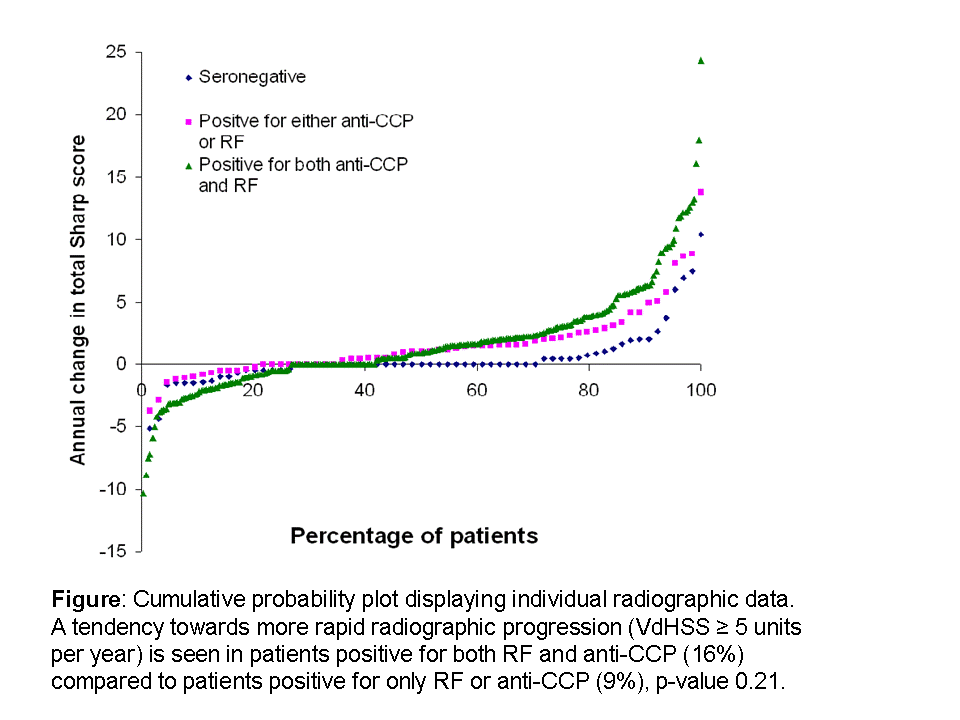Session Information
Session Type: Abstract Submissions (ACR)
Background/Purpose: During the last decade, rheumatoid arthritis (RA) research has mainly focused on early disease, as it has become apparent that early and aggressive treatment can change the long-term outcome of RA. However, most patients in clinical practice have established disease. Our objective was to describe the proportion of patients with established RA (≥5 years disease duration) who experience continued joint damage, and to identify its predictors.
Methods: We analyzed data from BRASS, an observational RA cohort. The data collection includes joint examinations, serological markers and patient reported outcome measures. Hand and wrist radiographs are acquired at baseline and 2 years and scored by van der Heijde-modified Sharp score (vdHSs). Patients with a disease duration ≥ 5 years and 2-year radiographic data (n=390) were selected, and progression of joint damage was defined as an annual change of ≥ 1 unit in total vdHSs. In univariate logistic regression models, we assessed the association between progressive joint damage and predictors such as age, gender, disease duration, treatment, DAS-28 category, subcutaneous nodules, seropositivity (classified as either negative for both RF and anti-CCP, positive for either RF or anti-CCP, or positive for both RF and anti-CCP), BMI and smoking. We then built a multivariate regression model, forcing DMARD treatment and disease duration into the model as covariates. Individual radiographic data stratified according to serological status were displayed in a cumulative probability plot.
Results: The median (IQR) age of the 390 patients was 60 (52, 67) years and the median disease duration was 17 (10, 27) years. 84% were female and 44% received biologic DMARD treatment. 16 % were negative for both RF and anti-CCP, 16 % were positive for either and 68 % were positive for both RF and anti-CCP. 44% (172) of the patients had progression of joint damage. Older age, longer disease duration, worse disease activity, seropositivity, normal BMI and no prior smoking had p-values <0.25 and were included in the model building. In multivariate logistic regression analyses, seropositivity was independently associated with joint damage. Positivity for either RF or anti-CCP had an OR (95% CI) of 5.0 (2.2, 11.1) and positivity for both serological markers an OR of 4.1 (2.1, 8.2) for subsequent joint damage. No other independent predictors were identified. Although the ORs for progressive joint damage were similar if patients were positive for one or both of RF and anti-CCP, patients who were positive for both RF and anti-CCP tended to experience more joint damage (Figure).
Conclusion: Progression of joint damage is still common in RA patients with at least five years disease duration, even in a setting where 44% of the patients receive biologic DMARDs. Seropositivity is strongly and independently associated with joint damage.
Disclosure:
S. Lillegraven,
None;
N. A. Shadick,
Amgen,
2,
Abbott Immunology Pharmaceuticals,
2,
Genentech and Biogen IDEC Inc.,
2,
Crescendo Bioscience,
2,
Medimmune,
2;
Z. Jabbar-Lopez,
None;
A. Potapov,
None;
M. A. Frits,
None;
C. K. Iannaccone,
None;
E. A. Haavardsholm,
None;
T. K. Kvien,
Abbott Immunology Pharmaceuticals,
8,
AstraZeneca,
8,
Merck Pharmaceuticals,
8,
NiCox, S.A.,
8,
Pfizer Inc,
8,
Roche Pharmaceuticals,
8,
UCB,
8,
BMS,
5,
Abbott Immunology Pharmaceuticals,
5,
Merck Pharmaceuticals,
5,
NiCox, S.A.,
5,
Pfizer Inc,
5,
Roche Pharmaceuticals,
5,
UCB,
5,
Abbott Immunology Pharmaceuticals,
2,
Bristol-Myers Squibb,
2,
Merck Pharmaceuticals,
2,
Pfizer Inc,
2,
Roche Pharmaceuticals,
2,
UCB,
2;
M. Weinblatt,
MedImmune,
2,
Crescendo Bioscience,
2,
MedImmune,
5,
Crescendo Bioscience,
5;
D. H. Solomon,
Amgen and Lilly,
2,
Corrona,
5,
Pfizer Inc,
9,
UpToDate,
7.
« Back to 2012 ACR/ARHP Annual Meeting
ACR Meeting Abstracts - https://acrabstracts.org/abstract/progressive-radiographic-joint-damage-in-established-rheumatoid-arthritis-common-and-strongly-associated-with-seropositivity/


